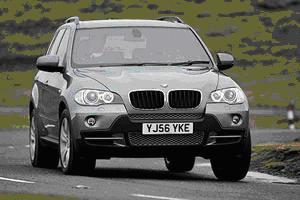BMW says it coined the phrase Sports Activity Vehicle – SAV, combining the presence of an SUV with the handling of a saloon car.
In 2007, BMW launched the second-generation X5 in answer to competition from the Porsche Cayenne and Volkswagen Touareg. We took to the road to find out if it can still compete with increasingly competent rivals.
There’s no denying the BMW X5 has massive presence on the road, but unlike some which trade on rugged looks, the X5 still has the blend of curves and angles which are now a BMW trademark.
There’s a familiarity with the BMW X5’s cabin – the convex dash which swoops away from the driver and passenger at the sides of the car and clear, well laid-out controls.
The second-generation BMW X5 sprouted a third row of seats to compete with the growing number of seven-seat SUVs on the market.
More good marks here, regardless of whether the 3- or 4.8-litre petrol or 3-litre diesel engine is specified.
A 2.7 tonne SUV isn’t going to be cheap to run, regardless of the engine chosen. The 3-litre diesel is the choice for economy, averaging 32.5mpg; the 3-litre and 4.8 will cover 25.9 and 22.6mpg respectively.
The BMW X5 feels like a solid machine, and the quality and fit and finish is commensurate with a premium-badged SUV costing upwards of £40,000.
It’s the SUV that thinks it’s a sports saloon, and as a result offers superbly handling and a range of potent engines.
